Uxbridge College L3: Business Communication & Info Management
VerifiedAdded on 2023/06/14
|12
|3555
|497
Report
AI Summary
This report examines Tesco's business communication and information management practices. It covers internal and external communication methods, data collection, storage, and usage, along with associated safeguards and legal compliance under the Data Protection Act 2018. The report details various communication methods such as bottom-up and top-down approaches, highlighting their advantages and disadvantages, and discusses barriers to effective communication and recommendations to overcome them. It also analyzes the types of data Tesco collects (transactional and master data), how this data is obtained, stored, and used, and evaluates the effectiveness of current data protection safeguards. The report further identifies relevant legislation and outlines an organization's obligations to comply with the law, providing a comprehensive overview of Tesco's approach to communication and information management.
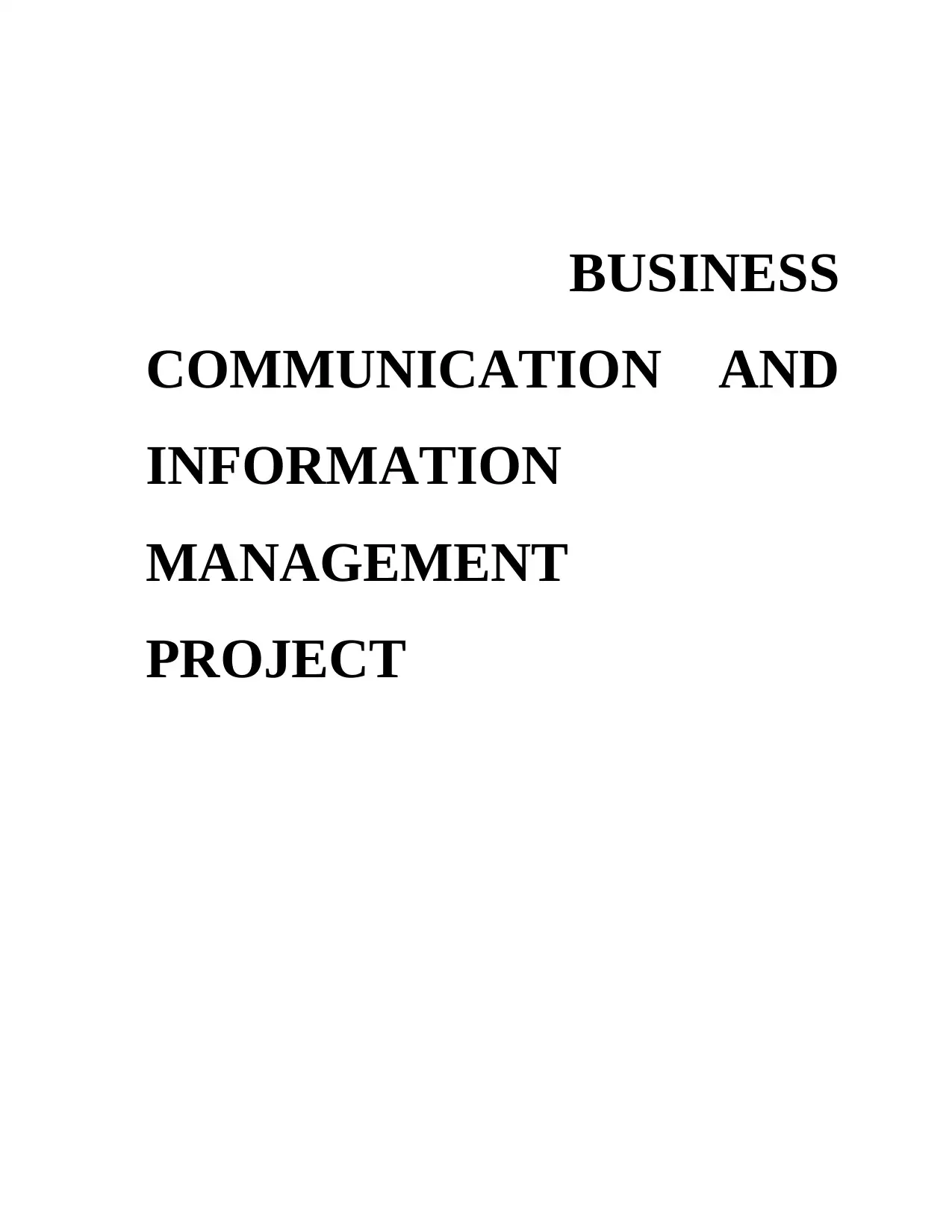
BUSINESS
COMMUNICATION AND
INFORMATION
MANAGEMENT
PROJECT
COMMUNICATION AND
INFORMATION
MANAGEMENT
PROJECT
Paraphrase This Document
Need a fresh take? Get an instant paraphrase of this document with our AI Paraphraser
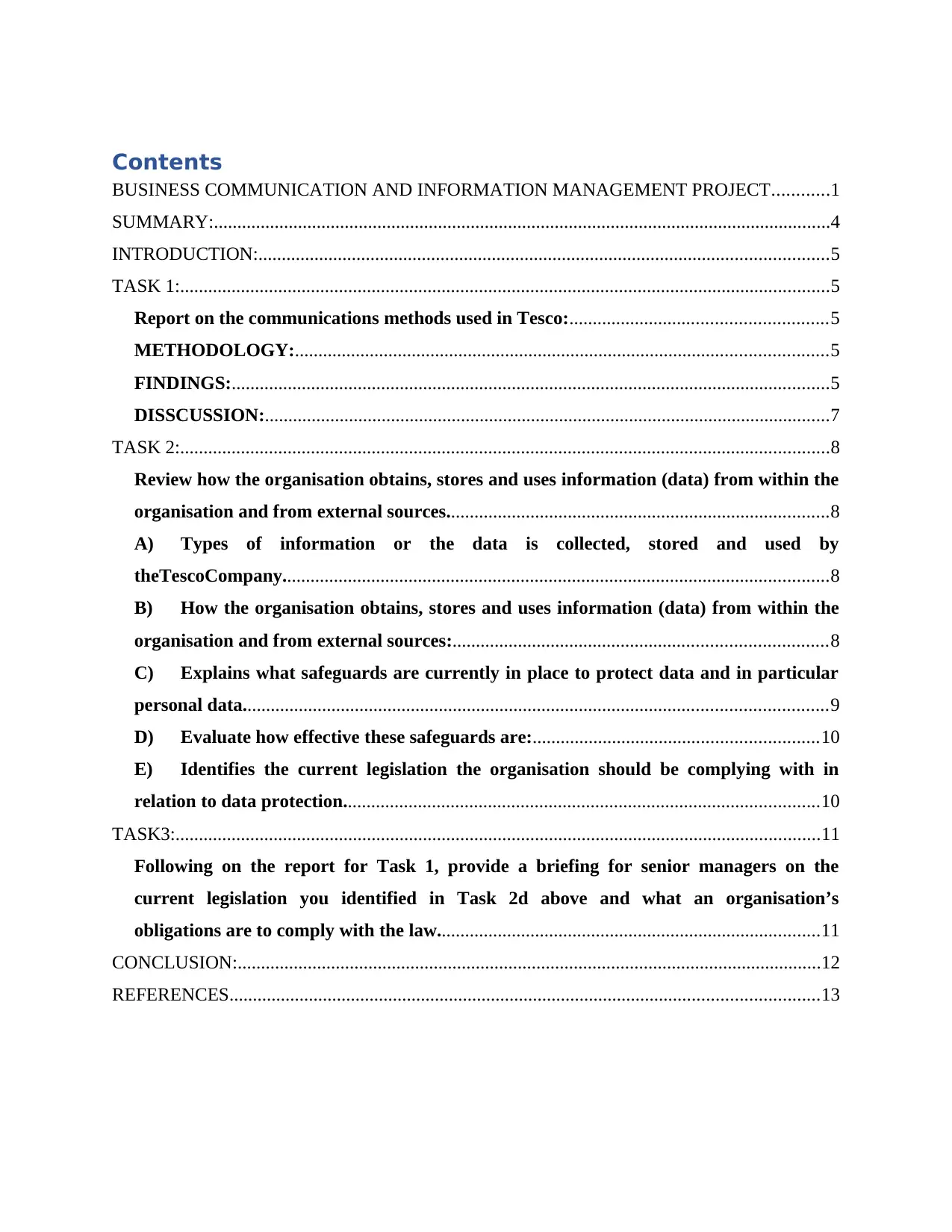
Contents
BUSINESS COMMUNICATION AND INFORMATION MANAGEMENT PROJECT............1
SUMMARY:....................................................................................................................................4
INTRODUCTION:..........................................................................................................................5
TASK 1:...........................................................................................................................................5
Report on the communications methods used in Tesco:.......................................................5
METHODOLOGY:..................................................................................................................5
FINDINGS:................................................................................................................................5
DISSCUSSION:.........................................................................................................................7
TASK 2:...........................................................................................................................................8
Review how the organisation obtains, stores and uses information (data) from within the
organisation and from external sources..................................................................................8
A) Types of information or the data is collected, stored and used by
theTescoCompany.....................................................................................................................8
B) How the organisation obtains, stores and uses information (data) from within the
organisation and from external sources:................................................................................8
C) Explains what safeguards are currently in place to protect data and in particular
personal data.............................................................................................................................9
D) Evaluate how effective these safeguards are:.............................................................10
E) Identifies the current legislation the organisation should be complying with in
relation to data protection......................................................................................................10
TASK3:..........................................................................................................................................11
Following on the report for Task 1, provide a briefing for senior managers on the
current legislation you identified in Task 2d above and what an organisation’s
obligations are to comply with the law..................................................................................11
CONCLUSION:.............................................................................................................................12
REFERENCES..............................................................................................................................13
BUSINESS COMMUNICATION AND INFORMATION MANAGEMENT PROJECT............1
SUMMARY:....................................................................................................................................4
INTRODUCTION:..........................................................................................................................5
TASK 1:...........................................................................................................................................5
Report on the communications methods used in Tesco:.......................................................5
METHODOLOGY:..................................................................................................................5
FINDINGS:................................................................................................................................5
DISSCUSSION:.........................................................................................................................7
TASK 2:...........................................................................................................................................8
Review how the organisation obtains, stores and uses information (data) from within the
organisation and from external sources..................................................................................8
A) Types of information or the data is collected, stored and used by
theTescoCompany.....................................................................................................................8
B) How the organisation obtains, stores and uses information (data) from within the
organisation and from external sources:................................................................................8
C) Explains what safeguards are currently in place to protect data and in particular
personal data.............................................................................................................................9
D) Evaluate how effective these safeguards are:.............................................................10
E) Identifies the current legislation the organisation should be complying with in
relation to data protection......................................................................................................10
TASK3:..........................................................................................................................................11
Following on the report for Task 1, provide a briefing for senior managers on the
current legislation you identified in Task 2d above and what an organisation’s
obligations are to comply with the law..................................................................................11
CONCLUSION:.............................................................................................................................12
REFERENCES..............................................................................................................................13
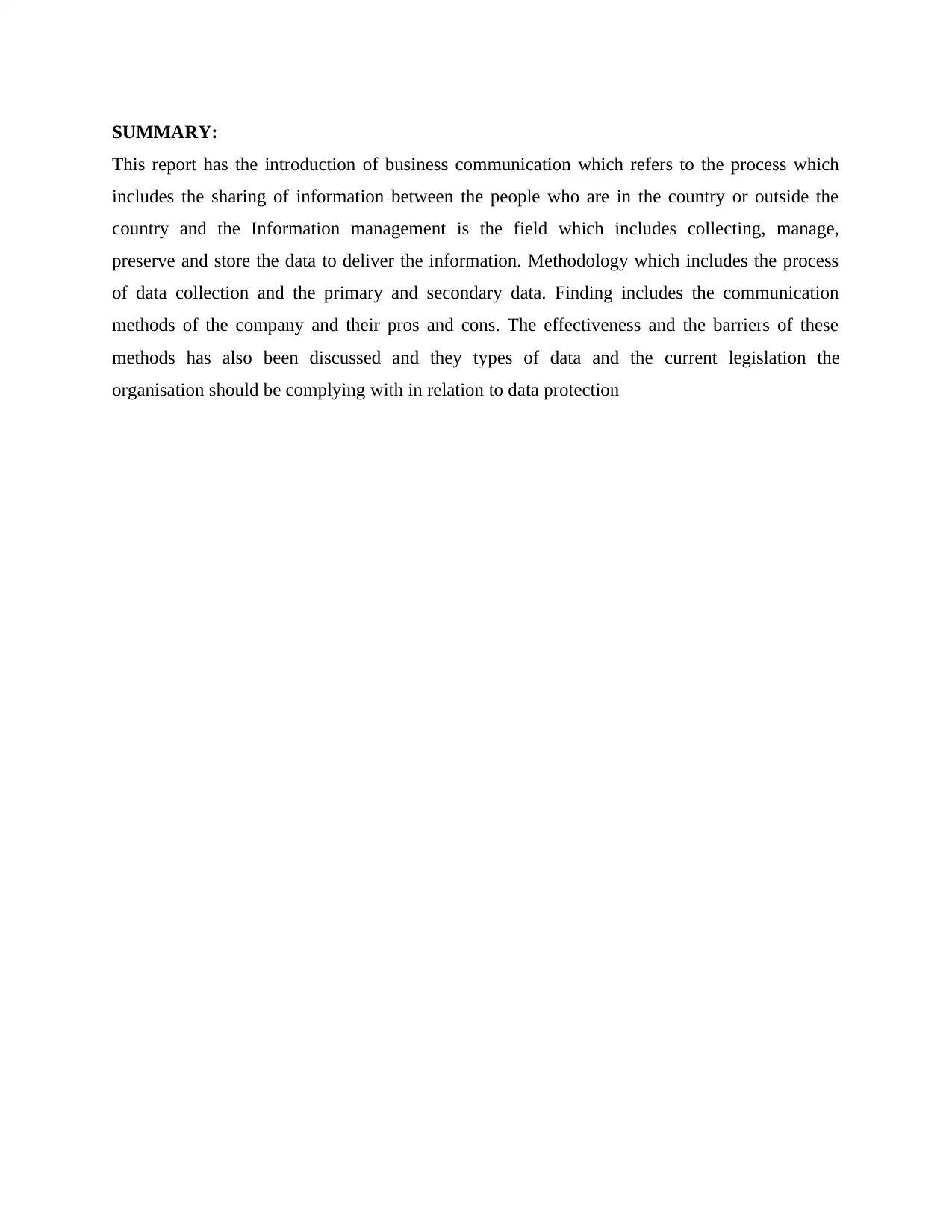
SUMMARY:
This report has the introduction of business communication which refers to the process which
includes the sharing of information between the people who are in the country or outside the
country and the Information management is the field which includes collecting, manage,
preserve and store the data to deliver the information. Methodology which includes the process
of data collection and the primary and secondary data. Finding includes the communication
methods of the company and their pros and cons. The effectiveness and the barriers of these
methods has also been discussed and they types of data and the current legislation the
organisation should be complying with in relation to data protection
This report has the introduction of business communication which refers to the process which
includes the sharing of information between the people who are in the country or outside the
country and the Information management is the field which includes collecting, manage,
preserve and store the data to deliver the information. Methodology which includes the process
of data collection and the primary and secondary data. Finding includes the communication
methods of the company and their pros and cons. The effectiveness and the barriers of these
methods has also been discussed and they types of data and the current legislation the
organisation should be complying with in relation to data protection
⊘ This is a preview!⊘
Do you want full access?
Subscribe today to unlock all pages.

Trusted by 1+ million students worldwide
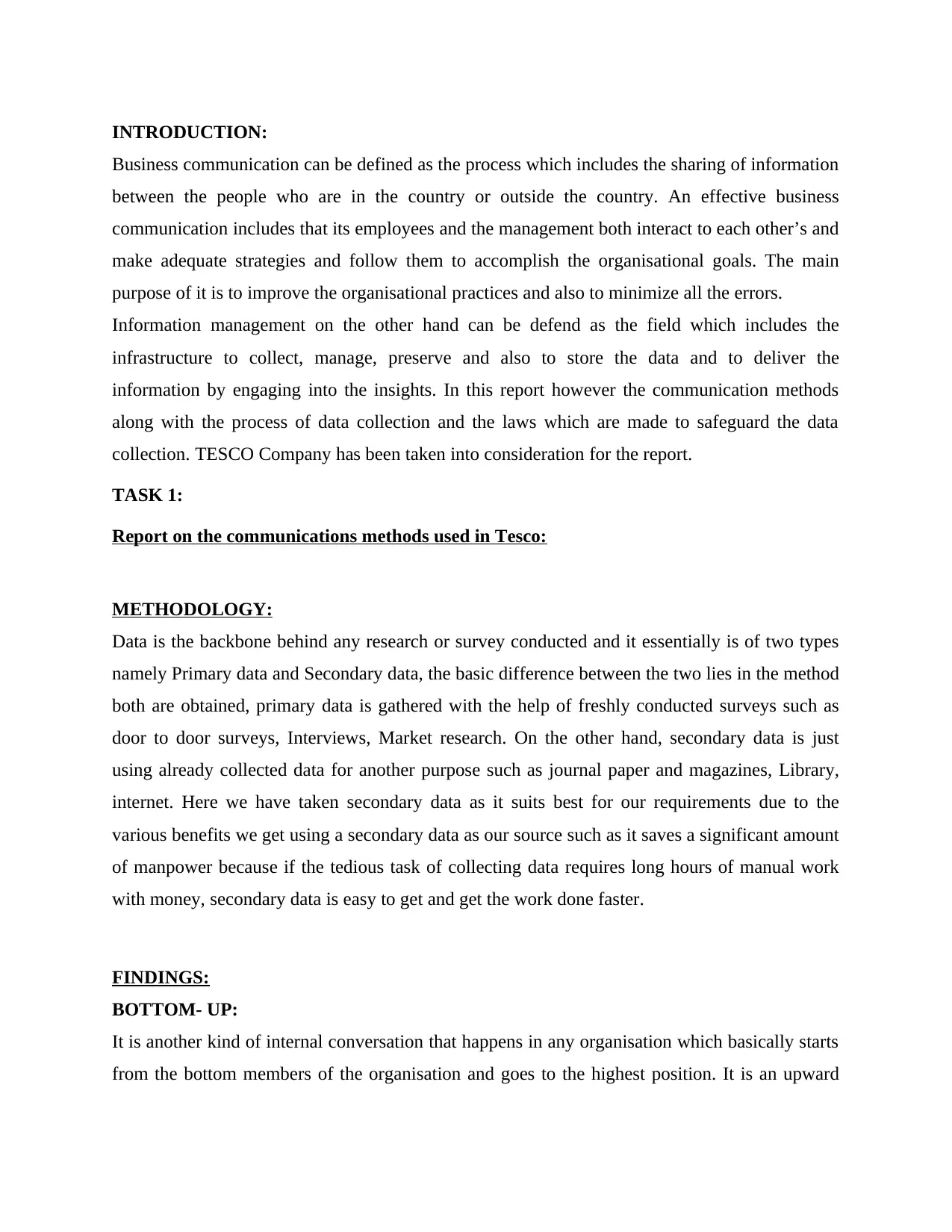
INTRODUCTION:
Business communication can be defined as the process which includes the sharing of information
between the people who are in the country or outside the country. An effective business
communication includes that its employees and the management both interact to each other’s and
make adequate strategies and follow them to accomplish the organisational goals. The main
purpose of it is to improve the organisational practices and also to minimize all the errors.
Information management on the other hand can be defend as the field which includes the
infrastructure to collect, manage, preserve and also to store the data and to deliver the
information by engaging into the insights. In this report however the communication methods
along with the process of data collection and the laws which are made to safeguard the data
collection. TESCO Company has been taken into consideration for the report.
TASK 1:
Report on the communications methods used in Tesco:
METHODOLOGY:
Data is the backbone behind any research or survey conducted and it essentially is of two types
namely Primary data and Secondary data, the basic difference between the two lies in the method
both are obtained, primary data is gathered with the help of freshly conducted surveys such as
door to door surveys, Interviews, Market research. On the other hand, secondary data is just
using already collected data for another purpose such as journal paper and magazines, Library,
internet. Here we have taken secondary data as it suits best for our requirements due to the
various benefits we get using a secondary data as our source such as it saves a significant amount
of manpower because if the tedious task of collecting data requires long hours of manual work
with money, secondary data is easy to get and get the work done faster.
FINDINGS:
BOTTOM- UP:
It is another kind of internal conversation that happens in any organisation which basically starts
from the bottom members of the organisation and goes to the highest position. It is an upward
Business communication can be defined as the process which includes the sharing of information
between the people who are in the country or outside the country. An effective business
communication includes that its employees and the management both interact to each other’s and
make adequate strategies and follow them to accomplish the organisational goals. The main
purpose of it is to improve the organisational practices and also to minimize all the errors.
Information management on the other hand can be defend as the field which includes the
infrastructure to collect, manage, preserve and also to store the data and to deliver the
information by engaging into the insights. In this report however the communication methods
along with the process of data collection and the laws which are made to safeguard the data
collection. TESCO Company has been taken into consideration for the report.
TASK 1:
Report on the communications methods used in Tesco:
METHODOLOGY:
Data is the backbone behind any research or survey conducted and it essentially is of two types
namely Primary data and Secondary data, the basic difference between the two lies in the method
both are obtained, primary data is gathered with the help of freshly conducted surveys such as
door to door surveys, Interviews, Market research. On the other hand, secondary data is just
using already collected data for another purpose such as journal paper and magazines, Library,
internet. Here we have taken secondary data as it suits best for our requirements due to the
various benefits we get using a secondary data as our source such as it saves a significant amount
of manpower because if the tedious task of collecting data requires long hours of manual work
with money, secondary data is easy to get and get the work done faster.
FINDINGS:
BOTTOM- UP:
It is another kind of internal conversation that happens in any organisation which basically starts
from the bottom members of the organisation and goes to the highest position. It is an upward
Paraphrase This Document
Need a fresh take? Get an instant paraphrase of this document with our AI Paraphraser
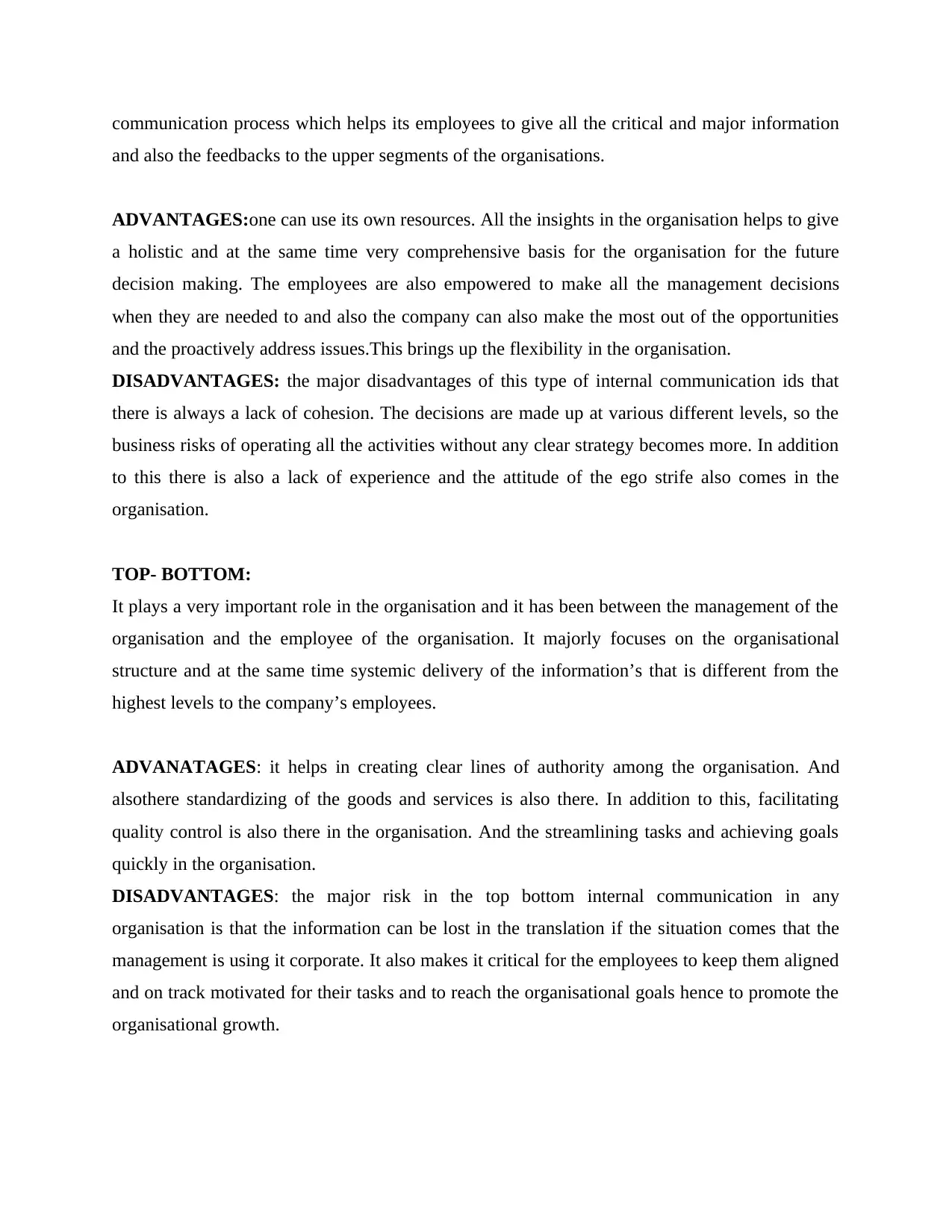
communication process which helps its employees to give all the critical and major information
and also the feedbacks to the upper segments of the organisations.
ADVANTAGES:one can use its own resources. All the insights in the organisation helps to give
a holistic and at the same time very comprehensive basis for the organisation for the future
decision making. The employees are also empowered to make all the management decisions
when they are needed to and also the company can also make the most out of the opportunities
and the proactively address issues.This brings up the flexibility in the organisation.
DISADVANTAGES: the major disadvantages of this type of internal communication ids that
there is always a lack of cohesion. The decisions are made up at various different levels, so the
business risks of operating all the activities without any clear strategy becomes more. In addition
to this there is also a lack of experience and the attitude of the ego strife also comes in the
organisation.
TOP- BOTTOM:
It plays a very important role in the organisation and it has been between the management of the
organisation and the employee of the organisation. It majorly focuses on the organisational
structure and at the same time systemic delivery of the information’s that is different from the
highest levels to the company’s employees.
ADVANATAGES: it helps in creating clear lines of authority among the organisation. And
alsothere standardizing of the goods and services is also there. In addition to this, facilitating
quality control is also there in the organisation. And the streamlining tasks and achieving goals
quickly in the organisation.
DISADVANTAGES: the major risk in the top bottom internal communication in any
organisation is that the information can be lost in the translation if the situation comes that the
management is using it corporate. It also makes it critical for the employees to keep them aligned
and on track motivated for their tasks and to reach the organisational goals hence to promote the
organisational growth.
and also the feedbacks to the upper segments of the organisations.
ADVANTAGES:one can use its own resources. All the insights in the organisation helps to give
a holistic and at the same time very comprehensive basis for the organisation for the future
decision making. The employees are also empowered to make all the management decisions
when they are needed to and also the company can also make the most out of the opportunities
and the proactively address issues.This brings up the flexibility in the organisation.
DISADVANTAGES: the major disadvantages of this type of internal communication ids that
there is always a lack of cohesion. The decisions are made up at various different levels, so the
business risks of operating all the activities without any clear strategy becomes more. In addition
to this there is also a lack of experience and the attitude of the ego strife also comes in the
organisation.
TOP- BOTTOM:
It plays a very important role in the organisation and it has been between the management of the
organisation and the employee of the organisation. It majorly focuses on the organisational
structure and at the same time systemic delivery of the information’s that is different from the
highest levels to the company’s employees.
ADVANATAGES: it helps in creating clear lines of authority among the organisation. And
alsothere standardizing of the goods and services is also there. In addition to this, facilitating
quality control is also there in the organisation. And the streamlining tasks and achieving goals
quickly in the organisation.
DISADVANTAGES: the major risk in the top bottom internal communication in any
organisation is that the information can be lost in the translation if the situation comes that the
management is using it corporate. It also makes it critical for the employees to keep them aligned
and on track motivated for their tasks and to reach the organisational goals hence to promote the
organisational growth.
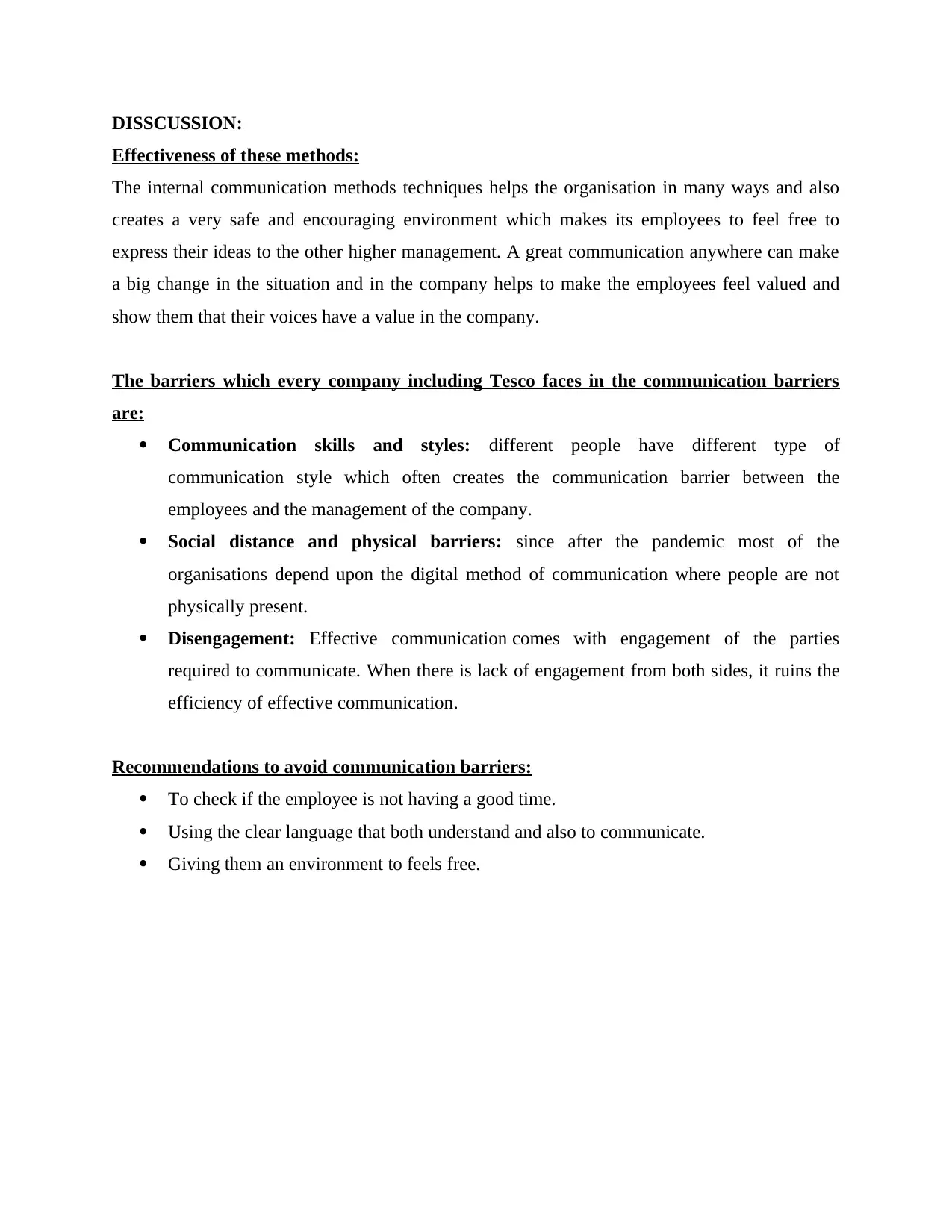
DISSCUSSION:
Effectiveness of these methods:
The internal communication methods techniques helps the organisation in many ways and also
creates a very safe and encouraging environment which makes its employees to feel free to
express their ideas to the other higher management. A great communication anywhere can make
a big change in the situation and in the company helps to make the employees feel valued and
show them that their voices have a value in the company.
The barriers which every company including Tesco faces in the communication barriers
are:
Communication skills and styles: different people have different type of
communication style which often creates the communication barrier between the
employees and the management of the company.
Social distance and physical barriers: since after the pandemic most of the
organisations depend upon the digital method of communication where people are not
physically present.
Disengagement: Effective communication comes with engagement of the parties
required to communicate. When there is lack of engagement from both sides, it ruins the
efficiency of effective communication.
Recommendations to avoid communication barriers:
To check if the employee is not having a good time.
Using the clear language that both understand and also to communicate.
Giving them an environment to feels free.
Effectiveness of these methods:
The internal communication methods techniques helps the organisation in many ways and also
creates a very safe and encouraging environment which makes its employees to feel free to
express their ideas to the other higher management. A great communication anywhere can make
a big change in the situation and in the company helps to make the employees feel valued and
show them that their voices have a value in the company.
The barriers which every company including Tesco faces in the communication barriers
are:
Communication skills and styles: different people have different type of
communication style which often creates the communication barrier between the
employees and the management of the company.
Social distance and physical barriers: since after the pandemic most of the
organisations depend upon the digital method of communication where people are not
physically present.
Disengagement: Effective communication comes with engagement of the parties
required to communicate. When there is lack of engagement from both sides, it ruins the
efficiency of effective communication.
Recommendations to avoid communication barriers:
To check if the employee is not having a good time.
Using the clear language that both understand and also to communicate.
Giving them an environment to feels free.
⊘ This is a preview!⊘
Do you want full access?
Subscribe today to unlock all pages.

Trusted by 1+ million students worldwide
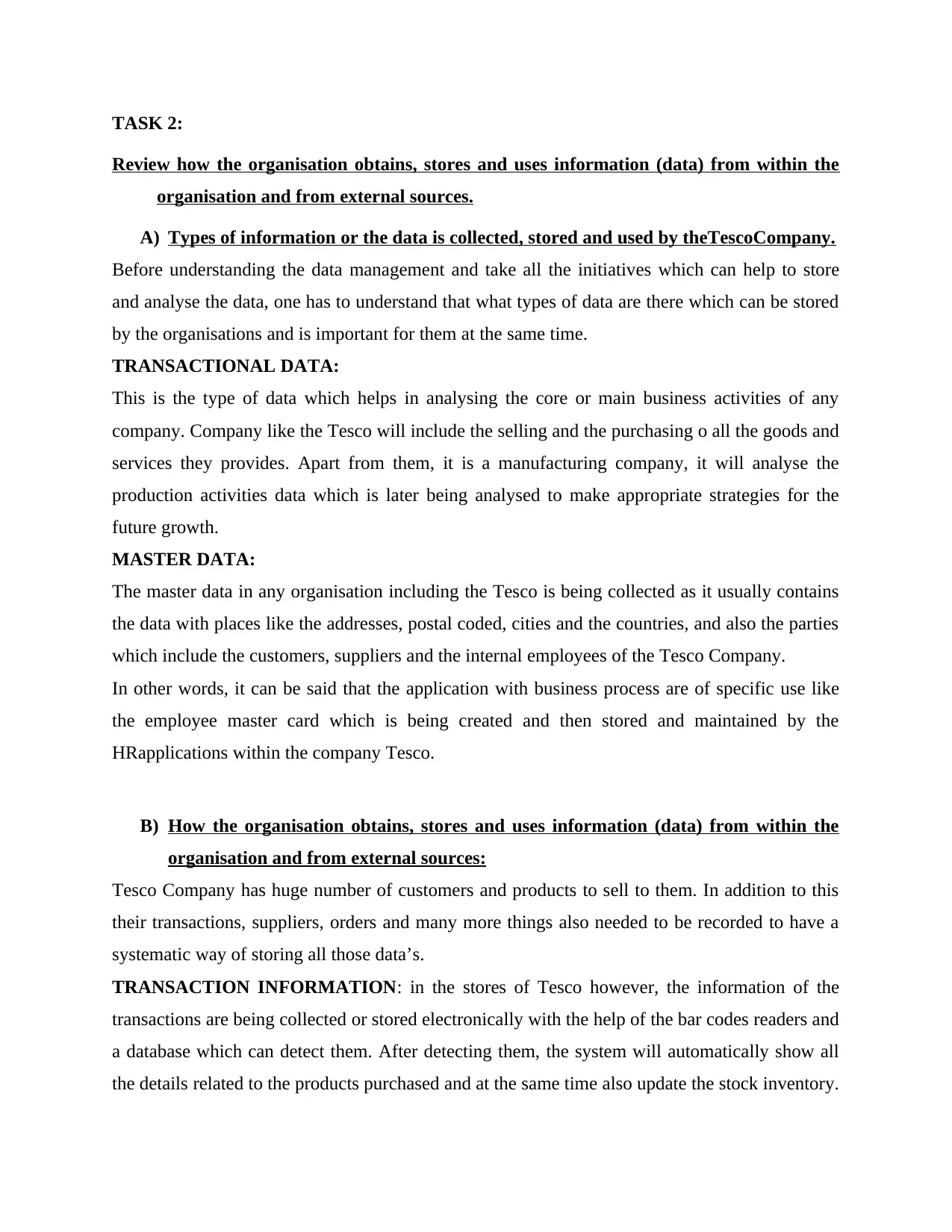
TASK 2:
Review how the organisation obtains, stores and uses information (data) from within the
organisation and from external sources.
A) Types of information or the data is collected, stored and used by theTescoCompany.
Before understanding the data management and take all the initiatives which can help to store
and analyse the data, one has to understand that what types of data are there which can be stored
by the organisations and is important for them at the same time.
TRANSACTIONAL DATA:
This is the type of data which helps in analysing the core or main business activities of any
company. Company like the Tesco will include the selling and the purchasing o all the goods and
services they provides. Apart from them, it is a manufacturing company, it will analyse the
production activities data which is later being analysed to make appropriate strategies for the
future growth.
MASTER DATA:
The master data in any organisation including the Tesco is being collected as it usually contains
the data with places like the addresses, postal coded, cities and the countries, and also the parties
which include the customers, suppliers and the internal employees of the Tesco Company.
In other words, it can be said that the application with business process are of specific use like
the employee master card which is being created and then stored and maintained by the
HRapplications within the company Tesco.
B) How the organisation obtains, stores and uses information (data) from within the
organisation and from external sources:
Tesco Company has huge number of customers and products to sell to them. In addition to this
their transactions, suppliers, orders and many more things also needed to be recorded to have a
systematic way of storing all those data’s.
TRANSACTION INFORMATION: in the stores of Tesco however, the information of the
transactions are being collected or stored electronically with the help of the bar codes readers and
a database which can detect them. After detecting them, the system will automatically show all
the details related to the products purchased and at the same time also update the stock inventory.
Review how the organisation obtains, stores and uses information (data) from within the
organisation and from external sources.
A) Types of information or the data is collected, stored and used by theTescoCompany.
Before understanding the data management and take all the initiatives which can help to store
and analyse the data, one has to understand that what types of data are there which can be stored
by the organisations and is important for them at the same time.
TRANSACTIONAL DATA:
This is the type of data which helps in analysing the core or main business activities of any
company. Company like the Tesco will include the selling and the purchasing o all the goods and
services they provides. Apart from them, it is a manufacturing company, it will analyse the
production activities data which is later being analysed to make appropriate strategies for the
future growth.
MASTER DATA:
The master data in any organisation including the Tesco is being collected as it usually contains
the data with places like the addresses, postal coded, cities and the countries, and also the parties
which include the customers, suppliers and the internal employees of the Tesco Company.
In other words, it can be said that the application with business process are of specific use like
the employee master card which is being created and then stored and maintained by the
HRapplications within the company Tesco.
B) How the organisation obtains, stores and uses information (data) from within the
organisation and from external sources:
Tesco Company has huge number of customers and products to sell to them. In addition to this
their transactions, suppliers, orders and many more things also needed to be recorded to have a
systematic way of storing all those data’s.
TRANSACTION INFORMATION: in the stores of Tesco however, the information of the
transactions are being collected or stored electronically with the help of the bar codes readers and
a database which can detect them. After detecting them, the system will automatically show all
the details related to the products purchased and at the same time also update the stock inventory.
Paraphrase This Document
Need a fresh take? Get an instant paraphrase of this document with our AI Paraphraser
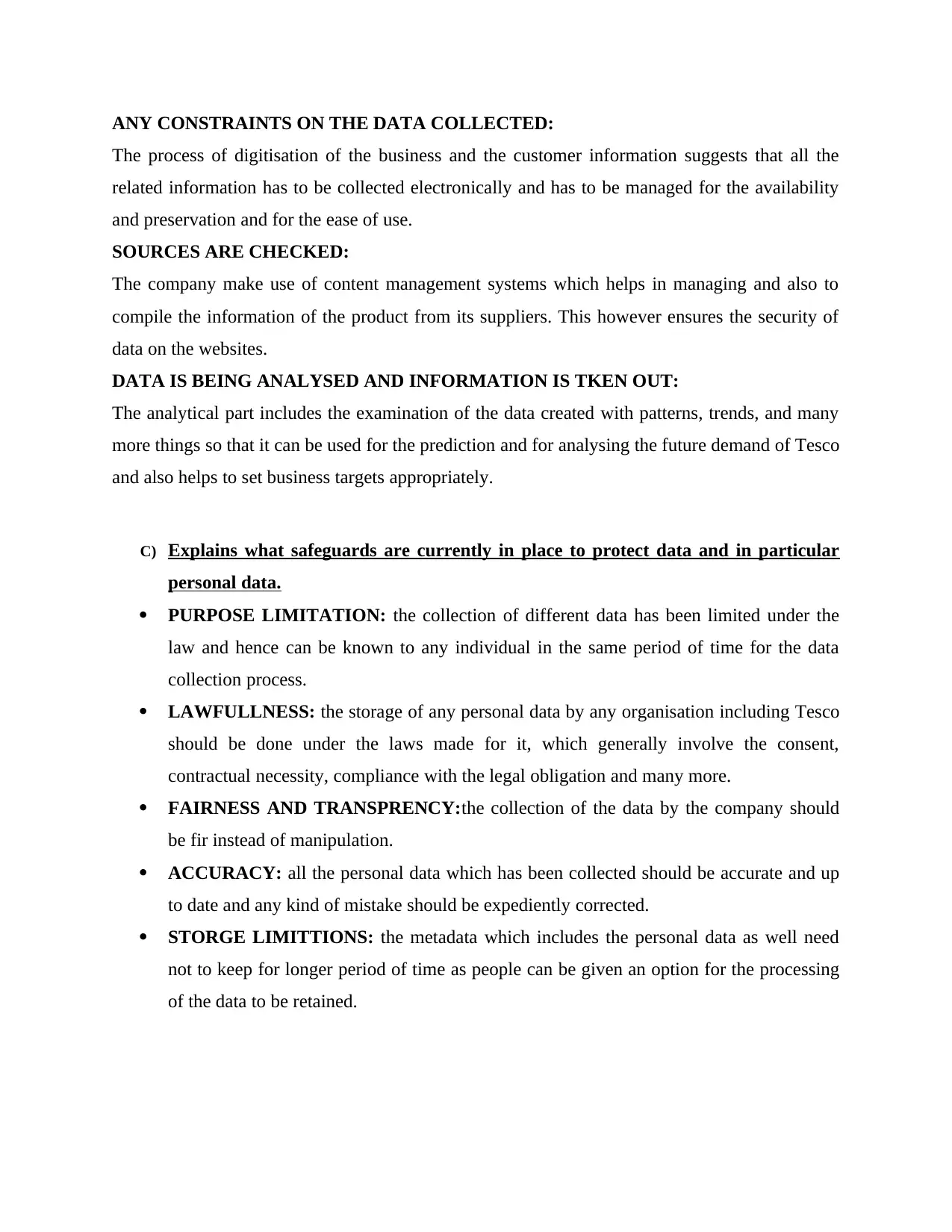
ANY CONSTRAINTS ON THE DATA COLLECTED:
The process of digitisation of the business and the customer information suggests that all the
related information has to be collected electronically and has to be managed for the availability
and preservation and for the ease of use.
SOURCES ARE CHECKED:
The company make use of content management systems which helps in managing and also to
compile the information of the product from its suppliers. This however ensures the security of
data on the websites.
DATA IS BEING ANALYSED AND INFORMATION IS TKEN OUT:
The analytical part includes the examination of the data created with patterns, trends, and many
more things so that it can be used for the prediction and for analysing the future demand of Tesco
and also helps to set business targets appropriately.
C) Explains what safeguards are currently in place to protect data and in particular
personal data.
PURPOSE LIMITATION: the collection of different data has been limited under the
law and hence can be known to any individual in the same period of time for the data
collection process.
LAWFULLNESS: the storage of any personal data by any organisation including Tesco
should be done under the laws made for it, which generally involve the consent,
contractual necessity, compliance with the legal obligation and many more.
FAIRNESS AND TRANSPRENCY:the collection of the data by the company should
be fir instead of manipulation.
ACCURACY: all the personal data which has been collected should be accurate and up
to date and any kind of mistake should be expediently corrected.
STORGE LIMITTIONS: the metadata which includes the personal data as well need
not to keep for longer period of time as people can be given an option for the processing
of the data to be retained.
The process of digitisation of the business and the customer information suggests that all the
related information has to be collected electronically and has to be managed for the availability
and preservation and for the ease of use.
SOURCES ARE CHECKED:
The company make use of content management systems which helps in managing and also to
compile the information of the product from its suppliers. This however ensures the security of
data on the websites.
DATA IS BEING ANALYSED AND INFORMATION IS TKEN OUT:
The analytical part includes the examination of the data created with patterns, trends, and many
more things so that it can be used for the prediction and for analysing the future demand of Tesco
and also helps to set business targets appropriately.
C) Explains what safeguards are currently in place to protect data and in particular
personal data.
PURPOSE LIMITATION: the collection of different data has been limited under the
law and hence can be known to any individual in the same period of time for the data
collection process.
LAWFULLNESS: the storage of any personal data by any organisation including Tesco
should be done under the laws made for it, which generally involve the consent,
contractual necessity, compliance with the legal obligation and many more.
FAIRNESS AND TRANSPRENCY:the collection of the data by the company should
be fir instead of manipulation.
ACCURACY: all the personal data which has been collected should be accurate and up
to date and any kind of mistake should be expediently corrected.
STORGE LIMITTIONS: the metadata which includes the personal data as well need
not to keep for longer period of time as people can be given an option for the processing
of the data to be retained.
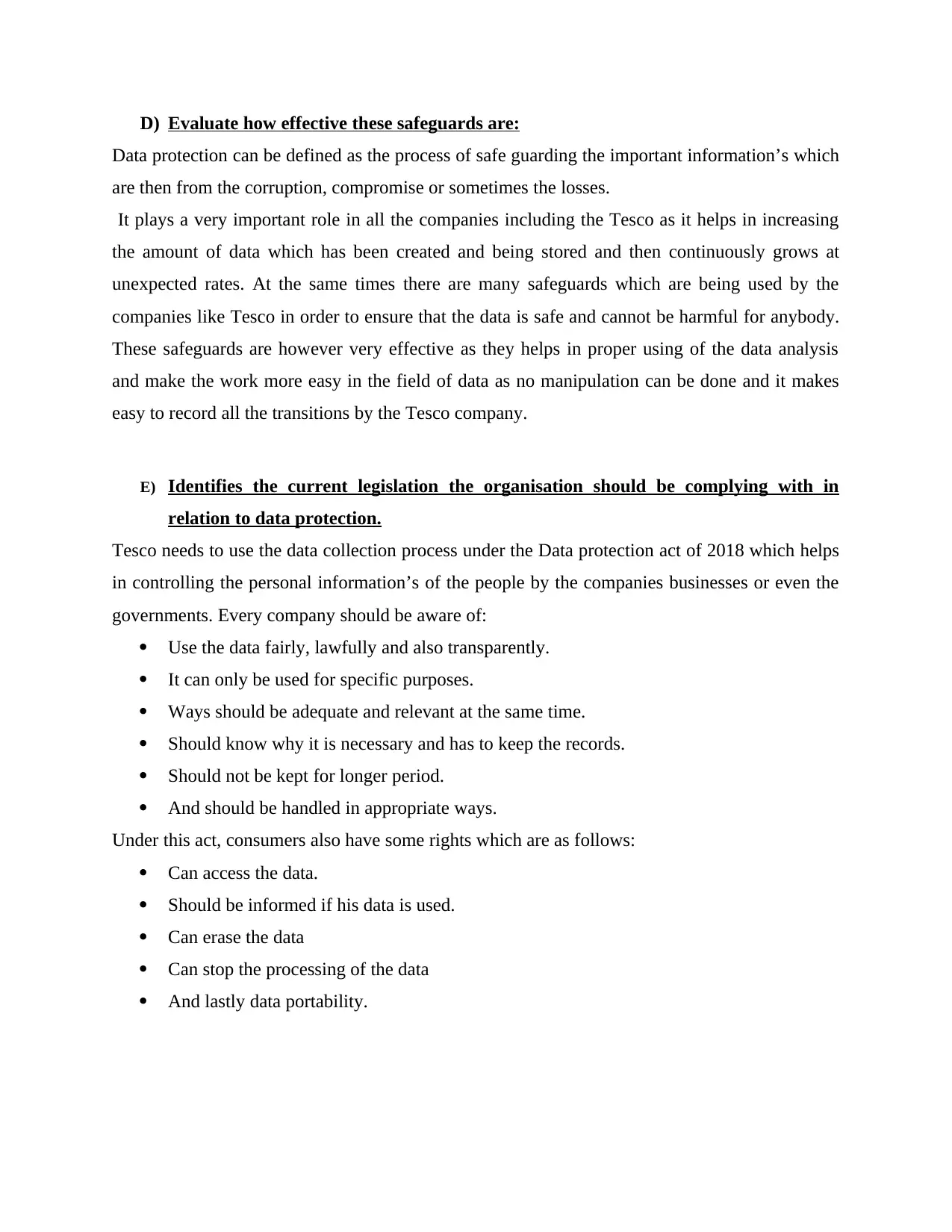
D) Evaluate how effective these safeguards are:
Data protection can be defined as the process of safe guarding the important information’s which
are then from the corruption, compromise or sometimes the losses.
It plays a very important role in all the companies including the Tesco as it helps in increasing
the amount of data which has been created and being stored and then continuously grows at
unexpected rates. At the same times there are many safeguards which are being used by the
companies like Tesco in order to ensure that the data is safe and cannot be harmful for anybody.
These safeguards are however very effective as they helps in proper using of the data analysis
and make the work more easy in the field of data as no manipulation can be done and it makes
easy to record all the transitions by the Tesco company.
E) Identifies the current legislation the organisation should be complying with in
relation to data protection.
Tesco needs to use the data collection process under the Data protection act of 2018 which helps
in controlling the personal information’s of the people by the companies businesses or even the
governments. Every company should be aware of:
Use the data fairly, lawfully and also transparently.
It can only be used for specific purposes.
Ways should be adequate and relevant at the same time.
Should know why it is necessary and has to keep the records.
Should not be kept for longer period.
And should be handled in appropriate ways.
Under this act, consumers also have some rights which are as follows:
Can access the data.
Should be informed if his data is used.
Can erase the data
Can stop the processing of the data
And lastly data portability.
Data protection can be defined as the process of safe guarding the important information’s which
are then from the corruption, compromise or sometimes the losses.
It plays a very important role in all the companies including the Tesco as it helps in increasing
the amount of data which has been created and being stored and then continuously grows at
unexpected rates. At the same times there are many safeguards which are being used by the
companies like Tesco in order to ensure that the data is safe and cannot be harmful for anybody.
These safeguards are however very effective as they helps in proper using of the data analysis
and make the work more easy in the field of data as no manipulation can be done and it makes
easy to record all the transitions by the Tesco company.
E) Identifies the current legislation the organisation should be complying with in
relation to data protection.
Tesco needs to use the data collection process under the Data protection act of 2018 which helps
in controlling the personal information’s of the people by the companies businesses or even the
governments. Every company should be aware of:
Use the data fairly, lawfully and also transparently.
It can only be used for specific purposes.
Ways should be adequate and relevant at the same time.
Should know why it is necessary and has to keep the records.
Should not be kept for longer period.
And should be handled in appropriate ways.
Under this act, consumers also have some rights which are as follows:
Can access the data.
Should be informed if his data is used.
Can erase the data
Can stop the processing of the data
And lastly data portability.
⊘ This is a preview!⊘
Do you want full access?
Subscribe today to unlock all pages.

Trusted by 1+ million students worldwide
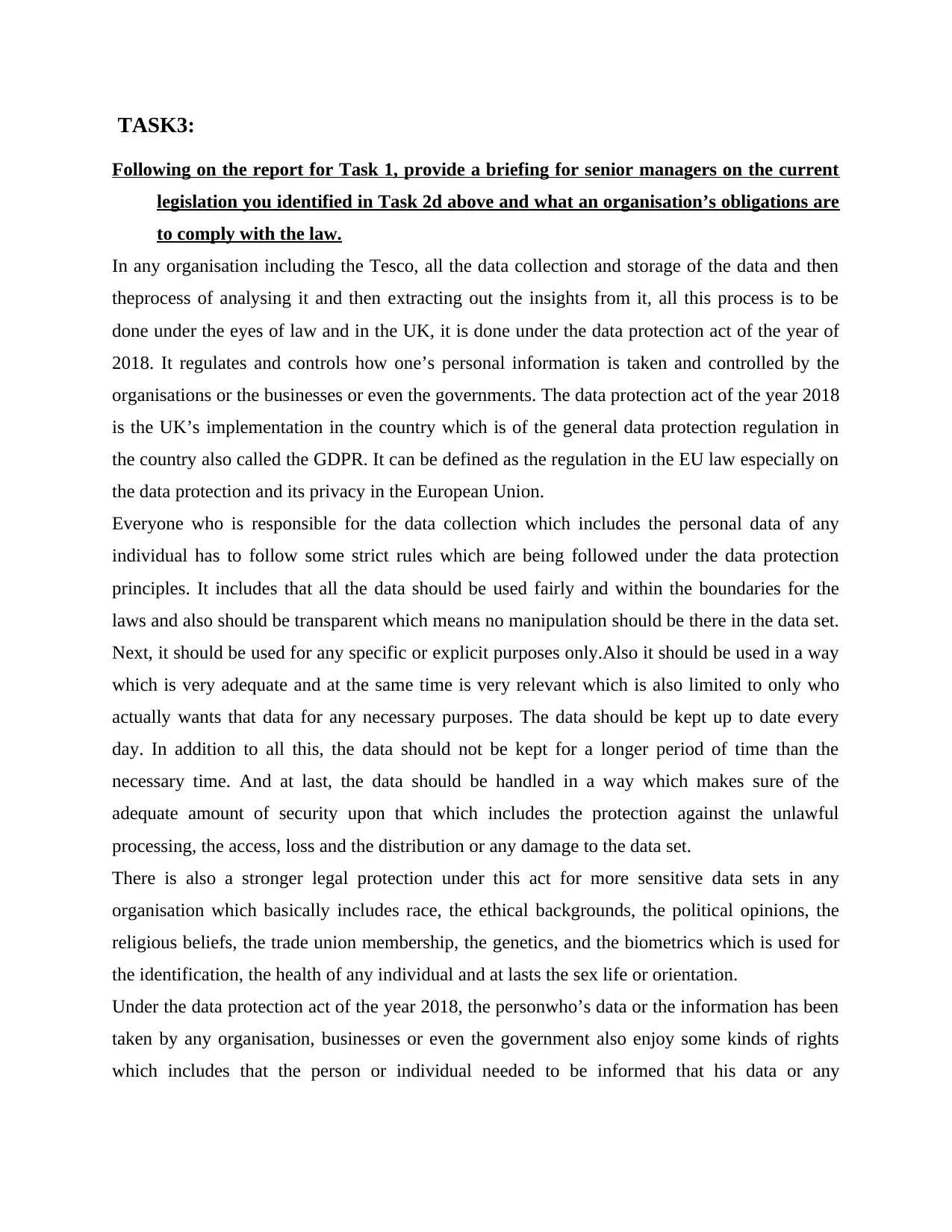
TASK3:
Following on the report for Task 1, provide a briefing for senior managers on the current
legislation you identified in Task 2d above and what an organisation’s obligations are
to comply with the law.
In any organisation including the Tesco, all the data collection and storage of the data and then
theprocess of analysing it and then extracting out the insights from it, all this process is to be
done under the eyes of law and in the UK, it is done under the data protection act of the year of
2018. It regulates and controls how one’s personal information is taken and controlled by the
organisations or the businesses or even the governments. The data protection act of the year 2018
is the UK’s implementation in the country which is of the general data protection regulation in
the country also called the GDPR. It can be defined as the regulation in the EU law especially on
the data protection and its privacy in the European Union.
Everyone who is responsible for the data collection which includes the personal data of any
individual has to follow some strict rules which are being followed under the data protection
principles. It includes that all the data should be used fairly and within the boundaries for the
laws and also should be transparent which means no manipulation should be there in the data set.
Next, it should be used for any specific or explicit purposes only.Also it should be used in a way
which is very adequate and at the same time is very relevant which is also limited to only who
actually wants that data for any necessary purposes. The data should be kept up to date every
day. In addition to all this, the data should not be kept for a longer period of time than the
necessary time. And at last, the data should be handled in a way which makes sure of the
adequate amount of security upon that which includes the protection against the unlawful
processing, the access, loss and the distribution or any damage to the data set.
There is also a stronger legal protection under this act for more sensitive data sets in any
organisation which basically includes race, the ethical backgrounds, the political opinions, the
religious beliefs, the trade union membership, the genetics, and the biometrics which is used for
the identification, the health of any individual and at lasts the sex life or orientation.
Under the data protection act of the year 2018, the personwho’s data or the information has been
taken by any organisation, businesses or even the government also enjoy some kinds of rights
which includes that the person or individual needed to be informed that his data or any
Following on the report for Task 1, provide a briefing for senior managers on the current
legislation you identified in Task 2d above and what an organisation’s obligations are
to comply with the law.
In any organisation including the Tesco, all the data collection and storage of the data and then
theprocess of analysing it and then extracting out the insights from it, all this process is to be
done under the eyes of law and in the UK, it is done under the data protection act of the year of
2018. It regulates and controls how one’s personal information is taken and controlled by the
organisations or the businesses or even the governments. The data protection act of the year 2018
is the UK’s implementation in the country which is of the general data protection regulation in
the country also called the GDPR. It can be defined as the regulation in the EU law especially on
the data protection and its privacy in the European Union.
Everyone who is responsible for the data collection which includes the personal data of any
individual has to follow some strict rules which are being followed under the data protection
principles. It includes that all the data should be used fairly and within the boundaries for the
laws and also should be transparent which means no manipulation should be there in the data set.
Next, it should be used for any specific or explicit purposes only.Also it should be used in a way
which is very adequate and at the same time is very relevant which is also limited to only who
actually wants that data for any necessary purposes. The data should be kept up to date every
day. In addition to all this, the data should not be kept for a longer period of time than the
necessary time. And at last, the data should be handled in a way which makes sure of the
adequate amount of security upon that which includes the protection against the unlawful
processing, the access, loss and the distribution or any damage to the data set.
There is also a stronger legal protection under this act for more sensitive data sets in any
organisation which basically includes race, the ethical backgrounds, the political opinions, the
religious beliefs, the trade union membership, the genetics, and the biometrics which is used for
the identification, the health of any individual and at lasts the sex life or orientation.
Under the data protection act of the year 2018, the personwho’s data or the information has been
taken by any organisation, businesses or even the government also enjoy some kinds of rights
which includes that the person or individual needed to be informed that his data or any
Paraphrase This Document
Need a fresh take? Get an instant paraphrase of this document with our AI Paraphraser
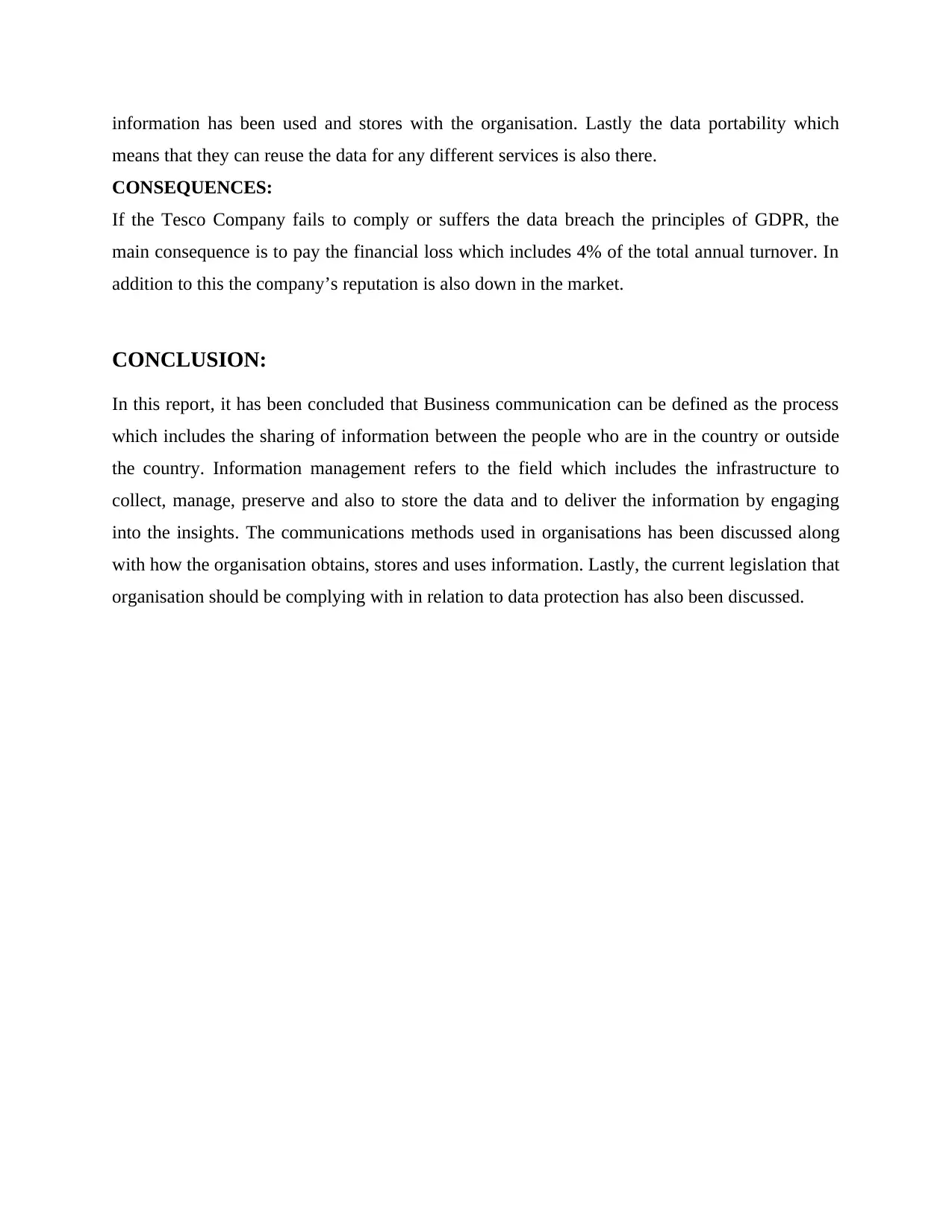
information has been used and stores with the organisation. Lastly the data portability which
means that they can reuse the data for any different services is also there.
CONSEQUENCES:
If the Tesco Company fails to comply or suffers the data breach the principles of GDPR, the
main consequence is to pay the financial loss which includes 4% of the total annual turnover. In
addition to this the company’s reputation is also down in the market.
CONCLUSION:
In this report, it has been concluded that Business communication can be defined as the process
which includes the sharing of information between the people who are in the country or outside
the country. Information management refers to the field which includes the infrastructure to
collect, manage, preserve and also to store the data and to deliver the information by engaging
into the insights. The communications methods used in organisations has been discussed along
with how the organisation obtains, stores and uses information. Lastly, the current legislation that
organisation should be complying with in relation to data protection has also been discussed.
means that they can reuse the data for any different services is also there.
CONSEQUENCES:
If the Tesco Company fails to comply or suffers the data breach the principles of GDPR, the
main consequence is to pay the financial loss which includes 4% of the total annual turnover. In
addition to this the company’s reputation is also down in the market.
CONCLUSION:
In this report, it has been concluded that Business communication can be defined as the process
which includes the sharing of information between the people who are in the country or outside
the country. Information management refers to the field which includes the infrastructure to
collect, manage, preserve and also to store the data and to deliver the information by engaging
into the insights. The communications methods used in organisations has been discussed along
with how the organisation obtains, stores and uses information. Lastly, the current legislation that
organisation should be complying with in relation to data protection has also been discussed.
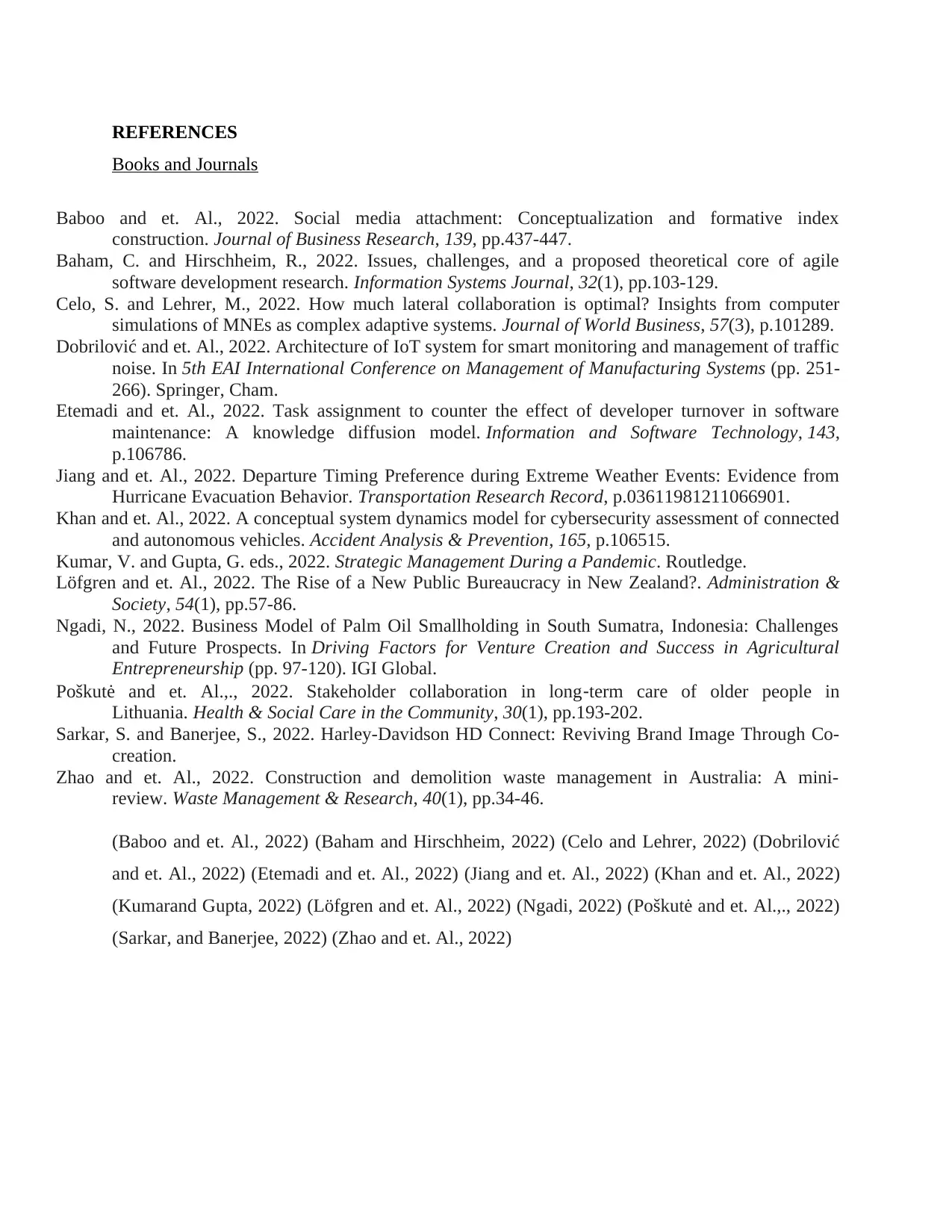
REFERENCES
Books and Journals
Baboo and et. Al., 2022. Social media attachment: Conceptualization and formative index
construction. Journal of Business Research, 139, pp.437-447.
Baham, C. and Hirschheim, R., 2022. Issues, challenges, and a proposed theoretical core of agile
software development research. Information Systems Journal, 32(1), pp.103-129.
Celo, S. and Lehrer, M., 2022. How much lateral collaboration is optimal? Insights from computer
simulations of MNEs as complex adaptive systems. Journal of World Business, 57(3), p.101289.
Dobrilović and et. Al., 2022. Architecture of IoT system for smart monitoring and management of traffic
noise. In 5th EAI International Conference on Management of Manufacturing Systems (pp. 251-
266). Springer, Cham.
Etemadi and et. Al., 2022. Task assignment to counter the effect of developer turnover in software
maintenance: A knowledge diffusion model. Information and Software Technology, 143,
p.106786.
Jiang and et. Al., 2022. Departure Timing Preference during Extreme Weather Events: Evidence from
Hurricane Evacuation Behavior. Transportation Research Record, p.03611981211066901.
Khan and et. Al., 2022. A conceptual system dynamics model for cybersecurity assessment of connected
and autonomous vehicles. Accident Analysis & Prevention, 165, p.106515.
Kumar, V. and Gupta, G. eds., 2022. Strategic Management During a Pandemic. Routledge.
Löfgren and et. Al., 2022. The Rise of a New Public Bureaucracy in New Zealand?. Administration &
Society, 54(1), pp.57-86.
Ngadi, N., 2022. Business Model of Palm Oil Smallholding in South Sumatra, Indonesia: Challenges
and Future Prospects. In Driving Factors for Venture Creation and Success in Agricultural
Entrepreneurship (pp. 97-120). IGI Global.
Poškutė and et. Al.,., 2022. Stakeholder collaboration in long‐term care of older people in
Lithuania. Health & Social Care in the Community, 30(1), pp.193-202.
Sarkar, S. and Banerjee, S., 2022. Harley-Davidson HD Connect: Reviving Brand Image Through Co-
creation.
Zhao and et. Al., 2022. Construction and demolition waste management in Australia: A mini-
review. Waste Management & Research, 40(1), pp.34-46.
(Baboo and et. Al., 2022) (Baham and Hirschheim, 2022) (Celo and Lehrer, 2022) (Dobrilović
and et. Al., 2022) (Etemadi and et. Al., 2022) (Jiang and et. Al., 2022) (Khan and et. Al., 2022)
(Kumarand Gupta, 2022) (Löfgren and et. Al., 2022) (Ngadi, 2022) (Poškutė and et. Al.,., 2022)
(Sarkar, and Banerjee, 2022) (Zhao and et. Al., 2022)
Books and Journals
Baboo and et. Al., 2022. Social media attachment: Conceptualization and formative index
construction. Journal of Business Research, 139, pp.437-447.
Baham, C. and Hirschheim, R., 2022. Issues, challenges, and a proposed theoretical core of agile
software development research. Information Systems Journal, 32(1), pp.103-129.
Celo, S. and Lehrer, M., 2022. How much lateral collaboration is optimal? Insights from computer
simulations of MNEs as complex adaptive systems. Journal of World Business, 57(3), p.101289.
Dobrilović and et. Al., 2022. Architecture of IoT system for smart monitoring and management of traffic
noise. In 5th EAI International Conference on Management of Manufacturing Systems (pp. 251-
266). Springer, Cham.
Etemadi and et. Al., 2022. Task assignment to counter the effect of developer turnover in software
maintenance: A knowledge diffusion model. Information and Software Technology, 143,
p.106786.
Jiang and et. Al., 2022. Departure Timing Preference during Extreme Weather Events: Evidence from
Hurricane Evacuation Behavior. Transportation Research Record, p.03611981211066901.
Khan and et. Al., 2022. A conceptual system dynamics model for cybersecurity assessment of connected
and autonomous vehicles. Accident Analysis & Prevention, 165, p.106515.
Kumar, V. and Gupta, G. eds., 2022. Strategic Management During a Pandemic. Routledge.
Löfgren and et. Al., 2022. The Rise of a New Public Bureaucracy in New Zealand?. Administration &
Society, 54(1), pp.57-86.
Ngadi, N., 2022. Business Model of Palm Oil Smallholding in South Sumatra, Indonesia: Challenges
and Future Prospects. In Driving Factors for Venture Creation and Success in Agricultural
Entrepreneurship (pp. 97-120). IGI Global.
Poškutė and et. Al.,., 2022. Stakeholder collaboration in long‐term care of older people in
Lithuania. Health & Social Care in the Community, 30(1), pp.193-202.
Sarkar, S. and Banerjee, S., 2022. Harley-Davidson HD Connect: Reviving Brand Image Through Co-
creation.
Zhao and et. Al., 2022. Construction and demolition waste management in Australia: A mini-
review. Waste Management & Research, 40(1), pp.34-46.
(Baboo and et. Al., 2022) (Baham and Hirschheim, 2022) (Celo and Lehrer, 2022) (Dobrilović
and et. Al., 2022) (Etemadi and et. Al., 2022) (Jiang and et. Al., 2022) (Khan and et. Al., 2022)
(Kumarand Gupta, 2022) (Löfgren and et. Al., 2022) (Ngadi, 2022) (Poškutė and et. Al.,., 2022)
(Sarkar, and Banerjee, 2022) (Zhao and et. Al., 2022)
⊘ This is a preview!⊘
Do you want full access?
Subscribe today to unlock all pages.

Trusted by 1+ million students worldwide
1 out of 12
Related Documents
Your All-in-One AI-Powered Toolkit for Academic Success.
+13062052269
info@desklib.com
Available 24*7 on WhatsApp / Email
![[object Object]](/_next/static/media/star-bottom.7253800d.svg)
Unlock your academic potential
Copyright © 2020–2025 A2Z Services. All Rights Reserved. Developed and managed by ZUCOL.




